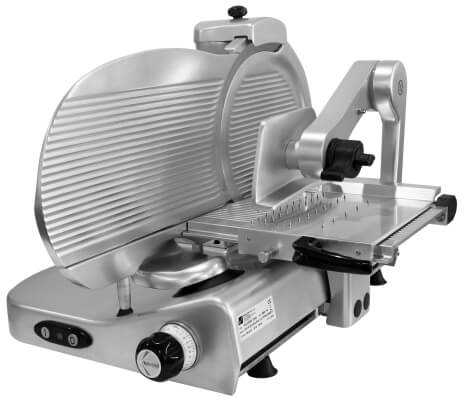


Consumer reviews home meat slicer full#
If you're making a grill full of burgers, a slicer is perfect for consistent onion slices or for tackling juicy and soft heirloom tomatoes that might otherwise get mangled by a serrated knife. Almost anything that needs consistent slices under a certain thickness can be cut on an electric slicer. Meat slicer FAQ What else are meat slicers good for?Ī. There are great options starting in the $300 range, and you can get your hands on a full-size slicer worthy of a 24-hour deli for around $2,000. Meat slicer costĪlthough it’s possible to spend less than $200 on a meat slicer, the really cheap ones aren’t likely to last long. If there’s no horsepower rating, it’s likely to have subpar nylon gears and a motor that’s prone to burning out during heavy use. If it has a blade measuring 9 inches or more, is made mostly of metal, and explicitly displays a horsepower rating, then it’s almost certain to be dependable enough for frequent use in the long term. This is another easy way to tell the weak slicers from the strong. An exterior made mostly of stainless steel is a good sign that you’re dealing with a quality piece of equipment.

If there’s plastic on the outside, it’s a fair assumption that there’s some plastic on the inside, too, and plastic components such as gears tend to not hold up well in high-torque applications. If you see a lot of plastic panels, you’re looking at a consumer-grade appliance. Construction qualityĪt first glance, you should be able to tell a fair amount about the slicer’s general quality. Starting in about the 8-inch range, you’ll probably notice a shift in the style and durability of slicers, which ties into our next point. As they get smaller, the number of commercial-grade units dwindles, and you’ll start to see a lot more consumer-oriented models. Unfortunately, it also maximizes the machine’s footprint. The majority of commercial slicers are in the 10- and 12-inch classes, and that kind of blade size maximizes usefulness. The most obvious difference between models, blade size determines just how many different foods you’re able to process with a given slicer. On the other hand, if you and those around you really, really like charcuterie, there are quite a few midsize models that are essentially replicas of the giant, professional-grade models, and many of them work quite well. If it’s just for occasional use to feed the household, you should be able to get by with something small and affordable, although it might not be ideal for prepping an entire banquet’s worth of food. Most home kitchens don’t have the counter or storage space for that kind of full-size, commercial-grade machine, but there are a handful of great options that are slightly smaller yet made with the same reliable internals and close tolerances that a restaurant kitchen demands.Īs a rule, though, don’t expect a compact meat slicer that fits in the cupboard to put out Earth-shattering amounts of horsepower. Watch the video to see some of our other winners.If you’ve ever worked in a restaurant or ordered a sandwich from an upscale deli, you’ve probably seen a massive, stainless-steel slicer humming away on the countertop at some point. All-in-all it was an awkward affair with food having to be cut to fit the chamber before pressure was applied. The third model, by Michael Graves, works by putting the vegies into a chamber and then squeezing the handle to force the food through the blades. Slicing tomatoes on the Food Network model, however, was more problematic and it's not dishwasher safe. We found the Zyliss easier to use and clean and it produced slices of a consistent size. Like traditional mandolins, using the Food Network and Zyliss models entails sliding the vegetables over the blade. We sliced tomatoes, onions, cucumbers and zucchini. You can pay $100 or more for one of these slicers but the ones in our tests ranged in price from $18 to $25. In addition to the 10 vegetable peelers, five can openers and other utensils tested in our kitchens, we tried three affordable mandolins. To prevent that, Consumer Reports tested 40 kitchen gadgets-peelers, graters, zesters, garlic presses, can openers and more-and found several that live up to their promises and others that don't. But once you get one home there's no guarantee that it won't end up in the junk drawer along with your other castoffs. With their low prices and promise of less work, new eye-catching kitchen gadgets are many a cooks' impulse buy.


 0 kommentar(er)
0 kommentar(er)
